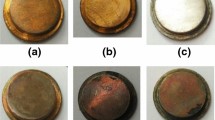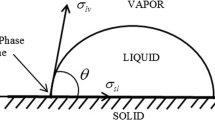Abstract
Surface with TiO2 nanotube arrays (TNTAs) is superhydrophilic and of great specific area. This paper investigates the pool boiling characteristics at the thermal interface with TNTAs. The results show that the TNTAs interface can enhance the pool boiling heat transfer compared to the pure Ti metal plate. The bubbles formed at the initial nucleation state are very small and released in higher frequency. The pool boiling heat transfer enhancement at the TNTAs interface may be attributed to the high density of nucleate site, high intrinsic heating area of nanotubes layer, superhydrophilicity and the vertically oriented nanotube structure.
Similar content being viewed by others
References
Theofanous T G, Tu J P, Dinh A T, et al. The boiling crisis phenomenon Part I: Nucleation and nucleate boiling heat transfer. Exp Therm Fluid Sci, 2002, 26(6–7): 775–792
Bergles A E, Chyu M C. Characteristics of nucleate pool boiling from porous metallic coatings. J Heat Trans-T ASME, 1982, 104(2): 279–285
Li C, Peterson G P, Wang Y X. Evaporation/boiling in thin capillary wicks (I)-wick thickness effects. J Heat Trans-T ASME, 2006, 128(12): 1312–1319
Liter S G, Kaviany M. Pool-boiling CHF enhancement by modulated porous-layer coating: Theory and experiment. Int J Heat Mass Tran, 2001, 44(22): 4287–4311
Das S K, Putra N, Roetzel W. Pool boiling characteristics of nano-fluids. Int J Heat Mass Tran, 2003, 46(5): 851–862
Hsu Y Y. On the size range of active nucleation cavities on a heating surface. J Heat Trans-T ASME, 1962, 84(3): 207–216
Yang S R, Kim R H. A mathematical model of the pool boiling nucleation site density in terms of the surface characteristics. Int J Heat Mass Tran, 1988, 31(6): 1127–1135
Peng X F, Hu H Y, Wang B X. Boiling nucleation during liquid flow in microchannels. Int J Heat Mass Tran, 1998, 41(1): 101–106
Ahn H S, Sinha N, Zhang M, et al. Pool boiling experiments on multiwalled carbon nanotube (MWCNT) forests. J Heat Trans-T ASME, 2006, 128(12): 1335–1342
Li S H, Furberg R, Toprak M S, et al. Nature-inspired boiling enhancement by novel nanostructured macroporous surfaces. Adv Funct Mater, 2008, 18(15): 2215–2220
Li C, Wang Z K, Wang P I, et al. Nanostructured copper interfaces for enhanced boiling. Small, 2008, 4(8): 1084–1088
Chen R, Lu M C, Srinivasan V, et al. Nanowires for enhanced boiling heat transfer. Nano Lett, 2009, 9(2): 548–533
Chen Y, Mo D C, Zhao H B, et al. Pool boiling performance at TiO2 nanotube interface (in Chineses). J Eng Thermophys, 2009, 30(4): 638–640
Zhang J T, Manglik R M. Additive adsorption and interfacial characteristics of nucleate pool boiling in aqueous surfactant solutions. J Heat Trans-T ASME, 2005, 127(7): 684–691
Takata Y, Hidaka S, Masuda M, et al. Pool boiling on a superhydrophilic surface. Int J Energ Res, 2003, 27(2): 111–119
Takata Y, Hidaka S, Cao J M, et al. Effect of surface wettability on boiling and evaporation. Energy, 2005, 30(2–4): 209–220
Kim S J, Bang I C, Buongiorno J, et al. Effects of nanoparticles deposition on surface wettability influencing boiling heat transfer in nanofluids. Appl Phys Lett, 2006, 89(15): 153107
Gong D, Grimes C A, Varghese O K, et al. Titanium oxide nanotube arrays prepared by anodic oxidation. J Mater Res, 2001, 16(12): 3331–3334
Zhao J L, Wang X H, Sun T Y, et al. Crystal phase transition and properties of titanium oxide nanotube arrays prepared by anodization. J Alloy Compd, 2007, 434–435: 792–795
Wang R, Hashimoto K, Fujishima A, et al. Photogeneration of highly amphiphilic TiO2 surfaces. Adv Mater, 1998, 10(2): 135–138
Hosono E, Matsuda H, Honma I, et al. Synthesis of a perpendicular TiO2 nanosheet film with the superhydrophilic property without UV irradiation. Langmuir, 2007, 23(14): 7447–7450
Attard P. Bridging bubbles between hydrophobic surfaces. Langmuir, 1996, 12(6): 1693–1695
Parker J L, Claesson P M, Attard P. Bubbles, cavities, and the long-ranged attraction between hydrophobic surfaces. J Phys Chem, 1994, 98(34): 8468–8480
Holmberg M, Kuhle A, Garnaes J, et al. Nanobubble trouble on gold surfaces. Langmuir, 2003, 19(25): 10510–10513
Cavicchi R E, Avedisian C T. Bubble nucleation and growth anomaly for a hydrophilic microheater attributed to metastable nanobubbles. Phys Rev Lett, 2007, 98(12): 124501
Author information
Authors and Affiliations
Corresponding author
Additional information
Supported by the National Natural Science Foundation of China (Grant No. 50846069)
Rights and permissions
About this article
Cite this article
Chen, Y., Mo, D., Zhao, H. et al. Pool boiling on the superhydrophilic surface with TiO2 nanotube arrays. Sci. China Ser. E-Technol. Sci. 52, 1596–1600 (2009). https://doi.org/10.1007/s11431-009-0195-0
Received:
Accepted:
Published:
Issue Date:
DOI: https://doi.org/10.1007/s11431-009-0195-0




